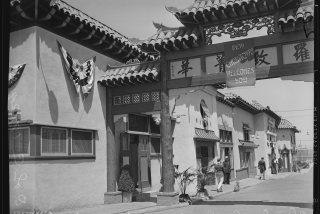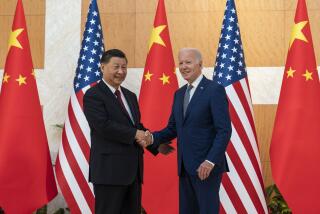A Revolution That Led to Modern-Day China
- Share via
Karl Marx believed his legacy would be cast in Germany. It never came to pass. Lenin brought it to life in Russia, where he converted Marxism into a working revolutionary doctrine, then strangled a country with it.
Cuba survived, but only as a client state. Nicaragua had its fling; so, in a fashion, did Chile, Zimbabwe, Ethiopia, Cambodia, Yemen. Even Italy flirted with its brand of communism, but Italy flirts with everything. North Korea swallowed some bleak version of it whole, and today sits starving in silence and isolation.
And then there is China.
It is striking to look today at the headlines from 1911 and 1912, when Sun Yat-sen toppled the most enduring empire on Earth. The stories do the event an injustice. It was front-page news, to be sure, but it battled for attention with the women’s suffrage vote, and it never got the focus that, say, Monica Lewinsky later was accorded. In those days, the revolution in China seemed more remote than the European revolts of the mid-1800s, and quickly gave way in Western history to World War I and the Russian Revolution of 1917.
Sun’s revolution, decades in the making, crested on Oct. 10, 1911, and broke the back of a 300-year-old dynasty. Without Sun, there would have been no Mao Tse-tung. And without Mao, China as we know it would not exist--for better and for worse.
Sun launched his revolution six years before Lenin arrived in Russia in a hooded train car to wrench Russia from the war and scorch its brief attempt at democracy. Unlike Lenin, Sun was not a Marxist and his revolution was not a communist overthrow, though Marx watched the gathering signs of Chinese instability in 1850 and admiringly noted that “it is to be rejoiced at that the most ancient and stable empire in the world . . . is on the eve of social upheaval.”
In 1911, an aspiring Chinese revolutionary could not even buy a copy of the Communist Manifesto. But Sun, born to peasant parents in China and raised by a wealthy brother in Hawaii, blended democratic principles, socialist sympathies and staggering persistence. So flexible was Sun in his appeals that he could win the backing of leftist opponents of the regime and still be labeled an “astute leader” on the front page of that day’s Los Angeles Times, no friend of leftists.
Most of all, Sun tapped the proud nationalism of a country that had been badly battered, the victim of one of a venal era’s most venal policies: the Western determination to break into Chinese trade by addicting as many people as possible to opium and then selling them what they needed to survive.
*
Sun ruled China only in a manner of speaking, wrestling with its far-flung interests and ever-shifting local allegiances. As his regime aged, it too fell victim to a vicious power struggle between two fierce opponents: the flinty, autocratic Chiang Kai-shek and his brutal thug of a counterpart, Mao.
Chiang looted graves, purged Sun’s party of communists and ultimately confronted Mao’s forces in armed conflict. When all was lost, he raided the treasures of the Forbidden City, the immense compound in Beijing where the empire was seated, loaded the loot into crates and hauled it with him and what was left of his army to Taiwan, where it remains.
China’s history then became Mao’s, with all the misery and conflict that entailed. The survival of Chinese communism is largely the result of two strategies which, like so many things in the country where it rules, exist partly in contradiction. Chinese communism lives because it is both rigid and flexible.
When Mikhail Gorbachev tried to reform the Soviet Union, he moved in half-steps. He loosened the reins on expression while trying to keep the economy under control. Soviet communism fell. The Chinese ruling party tries the opposite. It allows the economy, particularly in the south, to experiment while it squelches combative political speech. Within limits, an executive in China can buy American products and sell them for a profit. But try putting up a poster denouncing the Chinese Communist Party’s human rights record.
The result is a strange mixture, a kind of giddy chatter about the West’s most ephemeral institutions and skillful avoidance of its most lasting.
Just last year, Los Angeles Mayor Richard Riordan, a multimillionaire venture capitalist--in other words, a running dog enemy of the working class--was toasted in the Great Hall of the People and was feted by the president of the world’s largest communist power. He and his hosts avoided discussion of human rights, political dissent and Tibet. All went well.
The next afternoon, a tour guide shuttled many of Riordan’s business associates and friends through the Forbidden City.
She suggested that some of the tourists might already be familiar with the monument, home to emperors for eons, the historic and symbolic centerpiece to the world’s longest-lasting empire. After all, she said, it was featured in the movie “The Last Emperor.”
More to Read
Sign up for Essential California
The most important California stories and recommendations in your inbox every morning.
You may occasionally receive promotional content from the Los Angeles Times.














